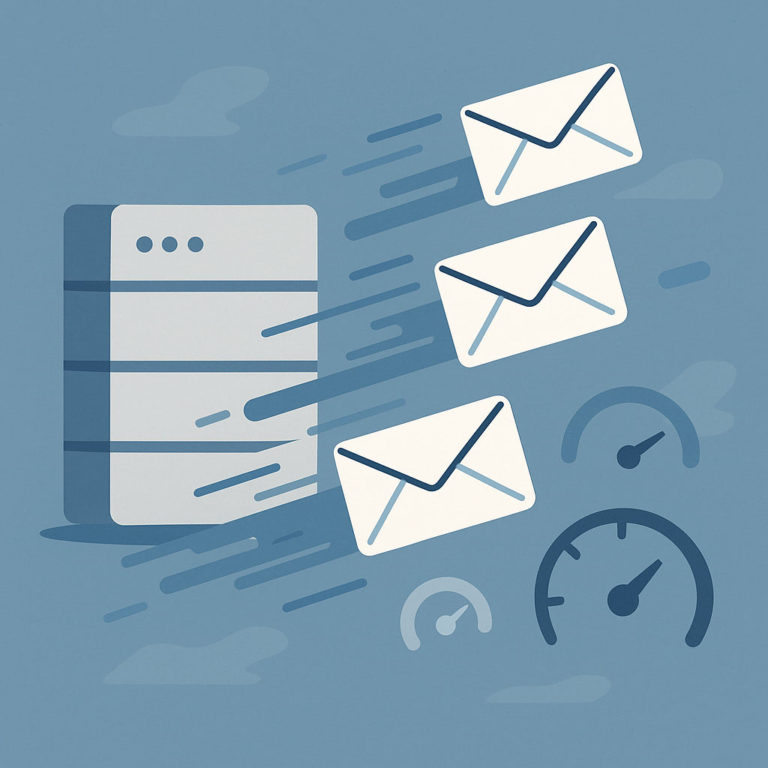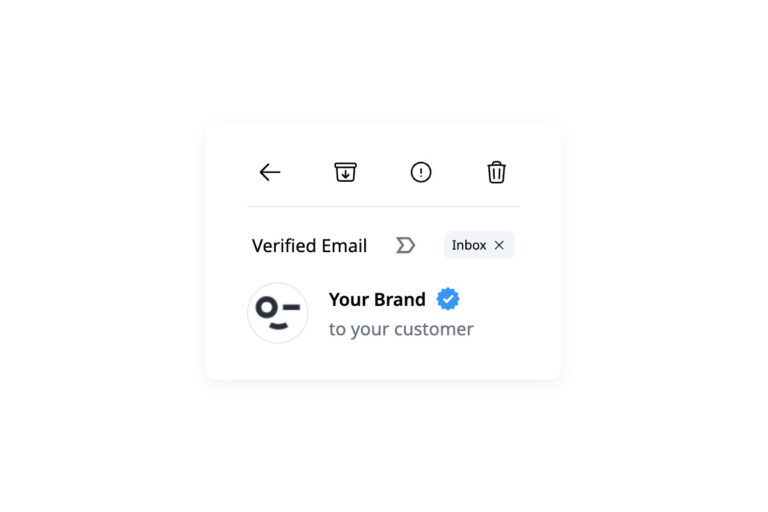With email marketing expecting to generate almost $18 billion in three years (according to Statista), it is no surprise that 80% of marketers say they would rather abandon social media than email. The tendency is that the industry continues growing and gaining more and more popularity.
Indeed, email marketing is an invaluable tool. It has an overall ROI of 4,200% and multiple perks that greatly benefit the company. However, unlocking its potential requires businesses to follow the law.
As many brands were abusing their email privileges, bombarding customers with digital newsletters, and leaving no space to breathe, laws have been introduced to stop this outrage. So-called GDPR and CAN-SPAM have come to the world to regulate the collection and use of personal data in email marketing. You have probably encountered one or more of these acronyms already. Every small and big business owner should obey them to be legally present in the email channel.
Let’s see in detail what each acronym means and consists of. We will discuss when you must adhere to one or the other. Plus, we will guide you through implementing regulations to keep your small business clear. But, first things first – why is mastering CAN-SPAM and GDPR compliance important for email marketers?
Compliance Checker
Importance of Mastering CAN-SPAM and GDPR Compliance for Email Marketers
First and foremost, staying CAN-SPAM and GDPR compliant allows your business to operate legally in email channels. Being non-compliant may cost the company over 50 thousand dollars in the U.S. or a staggering €20 million or 4% of the global turnover for the preceding financial year in Europe. Although fines are flexible and depend on the nature and duration of the GDPR violation, it may become a hefty hit to the wallet.
Second, everyone is obliged to obey the law. The law is for everyone regardless of size, age, target audience, and niche. There are no exceptions. For instance, Amazon paid a penalty of €746 million in 2021 for being incompliant with general data processing principles. In 2022, over 300 small businesses were charged with fines. You are no exception. Digital space is no longer “Wild Wild West.”
Third, it shows your respect for customers. One of the main directives of CAN-SPAM and GDPR is to get consent from potential subscribers to receive emails from the company. This act of asking an individual for permission to establish a connection and send messages shows your respect for them.
When the impression given by businesses says customers’ decisions are important, it builds healthy relationships between the company and clients. Customers are more willing to interact with the brand and respond positively to email campaigns. It leads to higher satisfaction with a product, better engagement, and more conversions.
Fourth, it builds a strong sender reputation. Obeying laws and providing customers with a comfortable and safe place in the email marketing area make a company a responsible partner in the eyes of subscribers and other participants, including internet service providers and email providers. It establishes a strong reputation across all fronts, allowing the company to pull off different campaigns and maximize email marketing efforts.
Fifth, it ensures the company’s stable presence in the email channel and strong position in the market. CAN-SPAM and GDPR advise companies to follow the best practices in the niche.
For example, apart from asking for consent, they also call for businesses to add an unsubscribe option. Practicing a “no strings attached” approach may sound controversial when you need to acquire new customers to stay afloat. However, it works because subscribers are free in their choices. Everyone appreciates freedom in corporate relationships.
On the other hand, this ideology forces companies not just to use email channels for chatting and promoting goods but, most importantly, to deliver value and give customers valid reasons to stay. It encourages the company to think through its campaigns and choose wisely, leading to better communication and responsible activity.
Finally, all regulations help combat spam and related cyber threats, including identity theft, phishing, and spreading malicious software. Studies already show the positive effect and huge difference for countries. For example, Canada is no longer on the list of countries with the world’s top 100 spamming organizations. Therefore, you create a safe environment for all parties in the email channel, including your company, subscribers, ISPs, and email providers.
So, meeting CAN-SPAM and GDPR compliances is crucial for many good reasons, from the brand’s successful existence and operations in the email channel to building a safe digital place. However, what are they? Presented as acronyms, they are far from being self-explanatory. Understanding what each act stands for is vital to knowing how to implement them in your email campaigns. Let’s get the hang of each one.
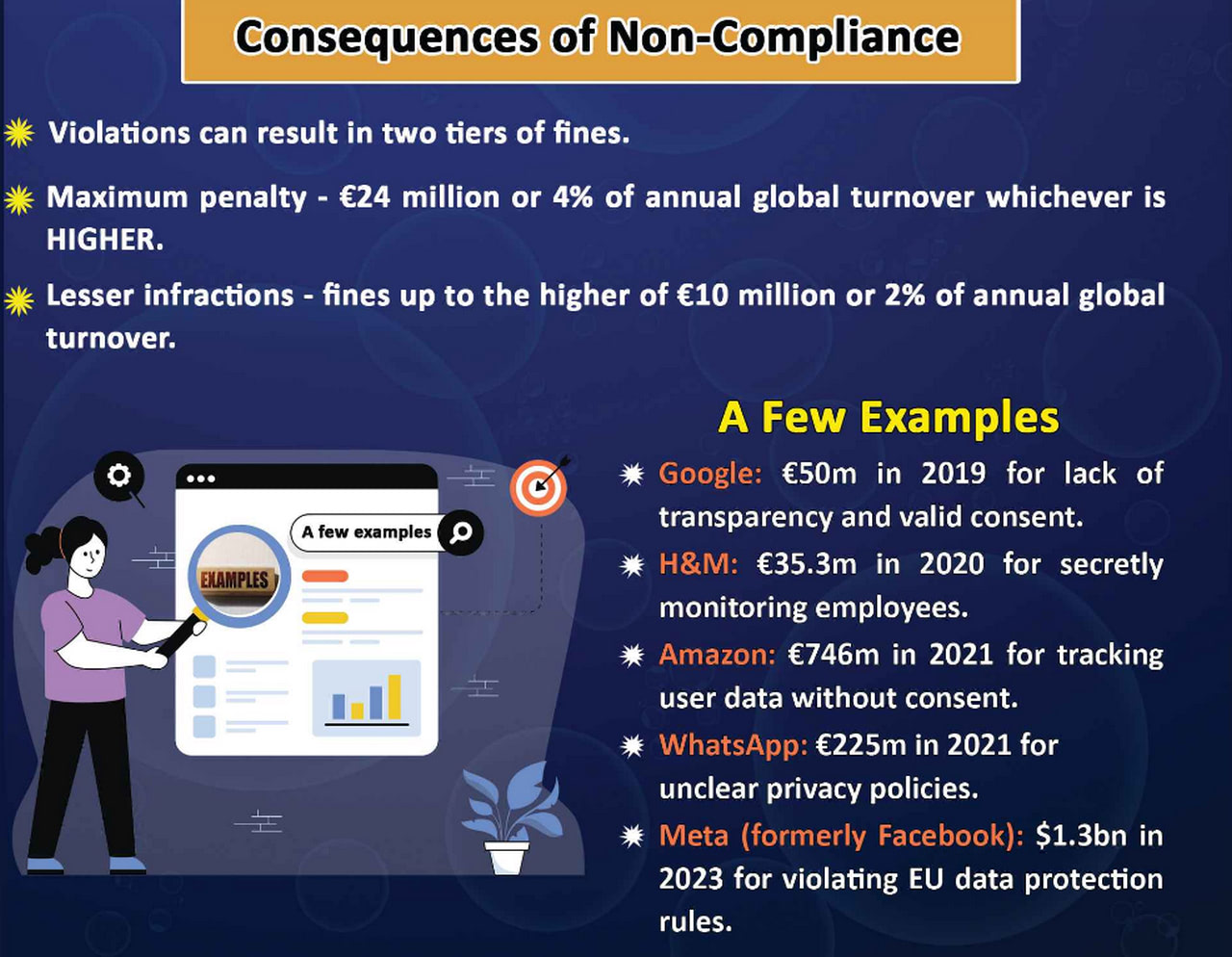
Consequences of non-compliance (visual snippet taken from Principles of GDPR infographic by Vista Infosec)
What Is CAN-SPAM and GDPR Compliance?
CAN-SPAM
CAN-SPAM stands for The Controlling the Assault of Non-Solicited Pornography and Marketing Act. It was introduced and enforced in 2003, becoming the first official U.S. law to provide guidelines for commercial email communication.
The law covers all electronic messages, even those with informative purposes. Each email is subject to penalties of up to $50,120.
Its main requirements are the following.:
- Use only original header information. Businesses must feature only the originating domain name and email address.
- Avoid misleading and deceptive subject lines. The latter must reflect the content clearly and concisely.
- Identify all advertisement emails. The body copy must not be misleading or deceptive.
- Provide subscribers with the company’s physical address. The location must include a postal address established under Postal Service regulations. Giving subscribers a return email address and other alternative ways to communicate with your company is highly recommended. Include links to active social media accounts, active chats with the support team, and telephone numbers.
- Add a clearly defined option to opt out of receiving future marketing emails. Ideally, every email should include an unsubscribe option, even if you want to say “Hi.”
- Establish a simple and clear opt-out mechanism. Again, companies should avoid deceptive routines that trick subscribers into staying with a brand.
- Businesses have ten days to honor recipients’ requests to opt-out and must require only their email addresses.
- Never sell subscribers’ email addresses.
- Take responsibility for third-party marketing tools in use. Brands must monitor their partners to ensure they also comply with the law.
Originally, CAN-SPAM offered guidelines for businesses that want to operate in the U.S. market. However, it has also become essential for companies with a global audience. It is the oldest of all compliances but not as comprehensive as merciless as GDPR.
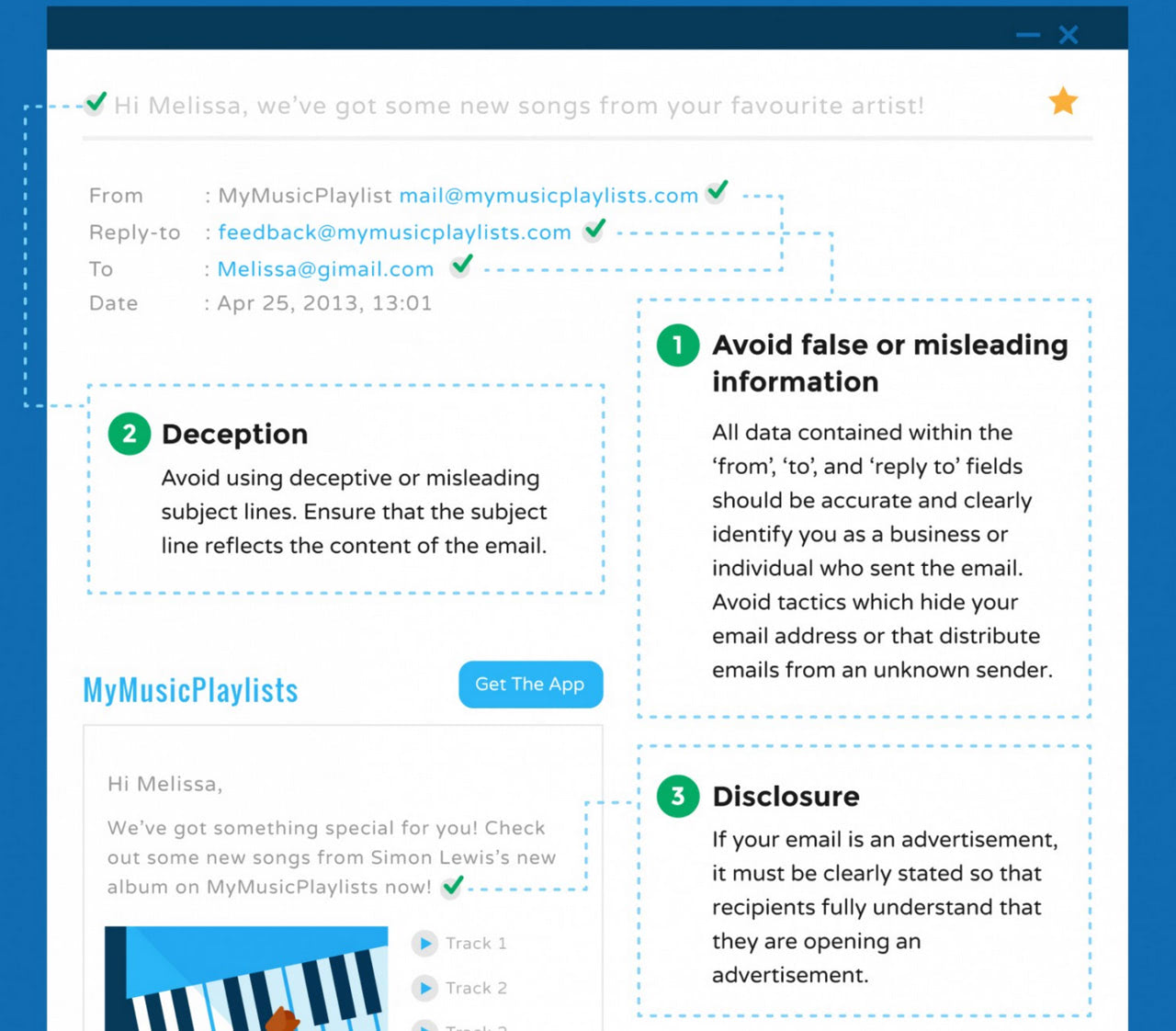
The beginner’s guide to CAN-SPAM (visual snippet taken from infographic by Venngage)
GDPR
GDPR stands for General Data Protection Regulation. It was enforced in 2018 and described how organizations must use personal data provided by clients. It aims to safeguard the data and privacy of European Union (EU) citizens. Much like CAN-SPAM, it also implies penalties for violations of the law. Businesses may face sanctions of up to a higher amount of 4% of their global sales.
Before moving to the GDPR basic requirements, it is crucial to understand what personal data is and ways to process it.
Personal data is any information that may identify a living person directly or indirectly. This includes name, phone number, physical address, email address, preferences, interests, and purchase history.
Processing data may include all sorts of actions with the client’s data. This includes collecting, organizing, storing, sharing, and even erasing and destroying data. Anytime you use and manipulate personal information, you process data.
All company’s actions concerning personal data and its processing must meet the following rules:
- All information must have clear and informed consent from individuals.
- All processing acts must be in line with integrity-friendly principles. Companies must inform subscribers how they will use their data and allow individuals to control it.
- All the processing acts must be safe, secure, and well-documented.
- Subscribers have a right to delete their data from the company’s database.
- Business owners must fulfill subscriber’s requests concerning their data promptly.
- The personal data usage must meet one of six alternatives to the legal basis.
- Companies must ensure data security. They have only 72 hours to report personal data breaches to the authorities and individuals.
- Companies are responsible for their partners. They must ensure their suppliers follow the data protection obligations.
- Companies must handle international data transfers and ensure the recipient country offers approved safeguards.
GDPR is the most rigorous law among all presented to this day. Whether inside the EU or outside, if you are an EU company that acts globally or you target EU citizens, you must obey this law.
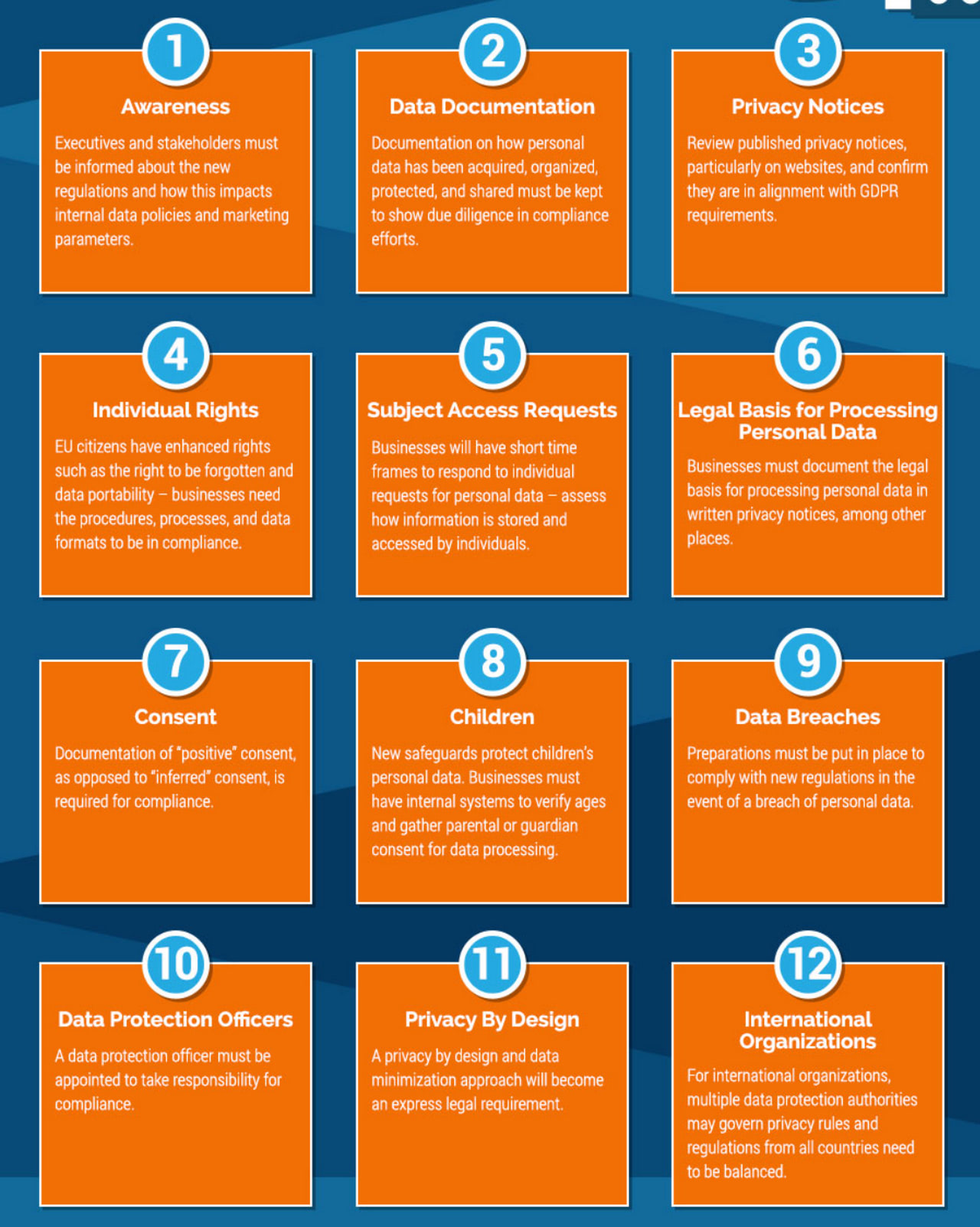
How to prepare for GDPR (visual snippet taken from infographic by Amplify)
Similarities in CAN-SPAM and GDPR
CAN-SPAM and GDPR aim to protect users and their data, establish certain rules for companies in their communication channels, and make the digital space safe. Even though they operate in different regions, they have many similarities, especially on a rudimentary level.
First of all, they enforce transparent ways to communicate with users. Companies must play fair with their clients and establish informed and consensual relationships.
Second, they protect data and require companies to devise ways to safeguard them.
Third, they force companies to monitor what others are doing on their behalf. Laws are clear on who is accountable.
Fourth, they require companies to provide transparent and simple mechanisms for opt-out. It brings to light the importance of having well-thought-out internal processes.
Finally, they come with fines and sanctions. Unlike speeding penalties, these are substantial. Companies can be charged up to $50,120for every email violating the CAN-SPAM Act or up to 4% of global revenue in case of GDPR non-compliance.
Differences between CAN-SPAM and GDPR
CAN-SPAM and GDPR have many similarities at the core but are still different. It may not be evident at first glance. Let’s make it a bit clear.
GDPR is the most strict and merciless law of all. It implies substantial fines and short terms to address issues. It is also the most pervasive. Providing a uniform standard for all of the EU’s 28 member states, it considers differences and comes up with a solution that fits all. Some non-EU countries follow this regulation or take it as a base for their laws as well, showing its global influence and significance.
When it comes to individual rights, GDPR excels again. While CAN-SPAM does not require companies to seek permission, GDPR is the stickiest with consent. It requires companies to get affirmative action from individuals for every specific purpose. Pre-checked boxes are not considered to be consent. On top of that, EU companies must provide their subscribers with a copy of their data if they ask to. If users want their data deleted, companies must honor this request promptly.
As for spam and cybercrimes, GDPR surpasses CAN-SPAM. The latter is a bit limited to prohibit outright spam. Even CASL (Californian law) is more rigorous about cyber threats like phishing and malware. In contrast, GDPR actively encourages companies and users to fight spam and cybercrimes.
On the other hand, CAN-SPAM is more prescriptive than GDPR, which focuses on principles companies must adopt. The U.S. law clarifies dos and don’ts and provides instructions. It is much easier to understand how to follow its regulations.
Finally, CAN-SPAM does not have age restrictions, whereas GDPR asks for parental consent for children under 16. Some states may lower this age to 13.
Whether you intend to keep your business inside home borders or dream of going globally, both regulations are vital to implement. As technology evolves, getting users from different countries is inevitable. You must handle their data without violations.
Moreover, with digital literacy continuing to rise, mastering CAN-SPAM and GDPR compliance for email marketing will no longer be an option. It will become a requirement, and users will actively support it. Therefore, today is the best time to fill this missing gap and ensure you follow the law. If you wonder how to do this, here is an 8-step routine.
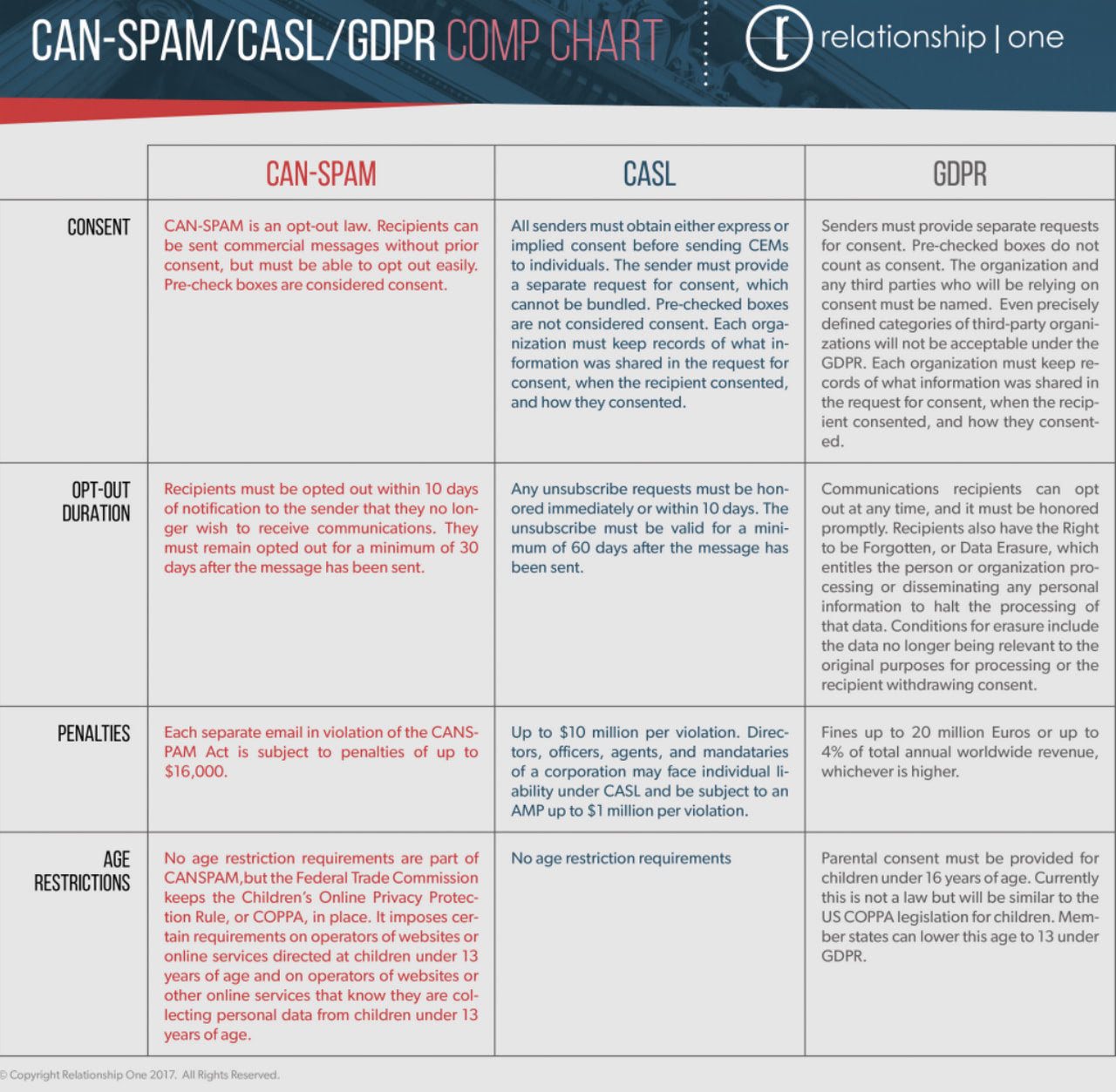
Comparison table for CAN-SPAM vs. GDPR vs. CASL (infographic taken from Relationship One)
How to Master CAN-SPAM and GDPR Compliance in Emails?
Building a CAN-SPAM- and GDPR-friendly email marketing strategy is incredibly easy despite featuring a dozen regulations. Follow this basic 8-step routine.
Step 1 – Get a thorough understanding of compliance.
Analyzing your user’s location will help you understand the laws you must follow. Start with the one that covers rules for your region. Then, move to others. Companies that operate in the U.S. may also consider CCPA. Your clients may come from California, and you might not even know that. You have to provide them with a level of data protection announced in their regulation act.
When exploring acts, it is crucial to understand all key details of each one to know how and when to introduce them in your email marketing routine to avoid fines and penalties.
On top of that, companies must be aware of the latest changes and updates because laws are constantly evolving. By staying up-to-date with CAN-SPAM and GDPR changes, brands ensure that they operate within the law, avoid fines and their aftermath, and adopt email marketing practices aligned with the latest best practices.
Step 2 – Prepare the ground.
Email marketing begins with your digital presence. Both laws draw companies’ attention to ways of acquiring new subscribers. Ensure your website, landing page, portal, or application where you collect subscribers meets the law.
At a minimum, this means adding a double opt-in form and seeking the subscriber’s permission to send all kinds of emails, from transactional to promotional. Although the CAN-SPAM Act does not require that, nevertheless, as one of the best practices in the digital world, it is highly recommended to do this even if you operate only within U.S. borders.
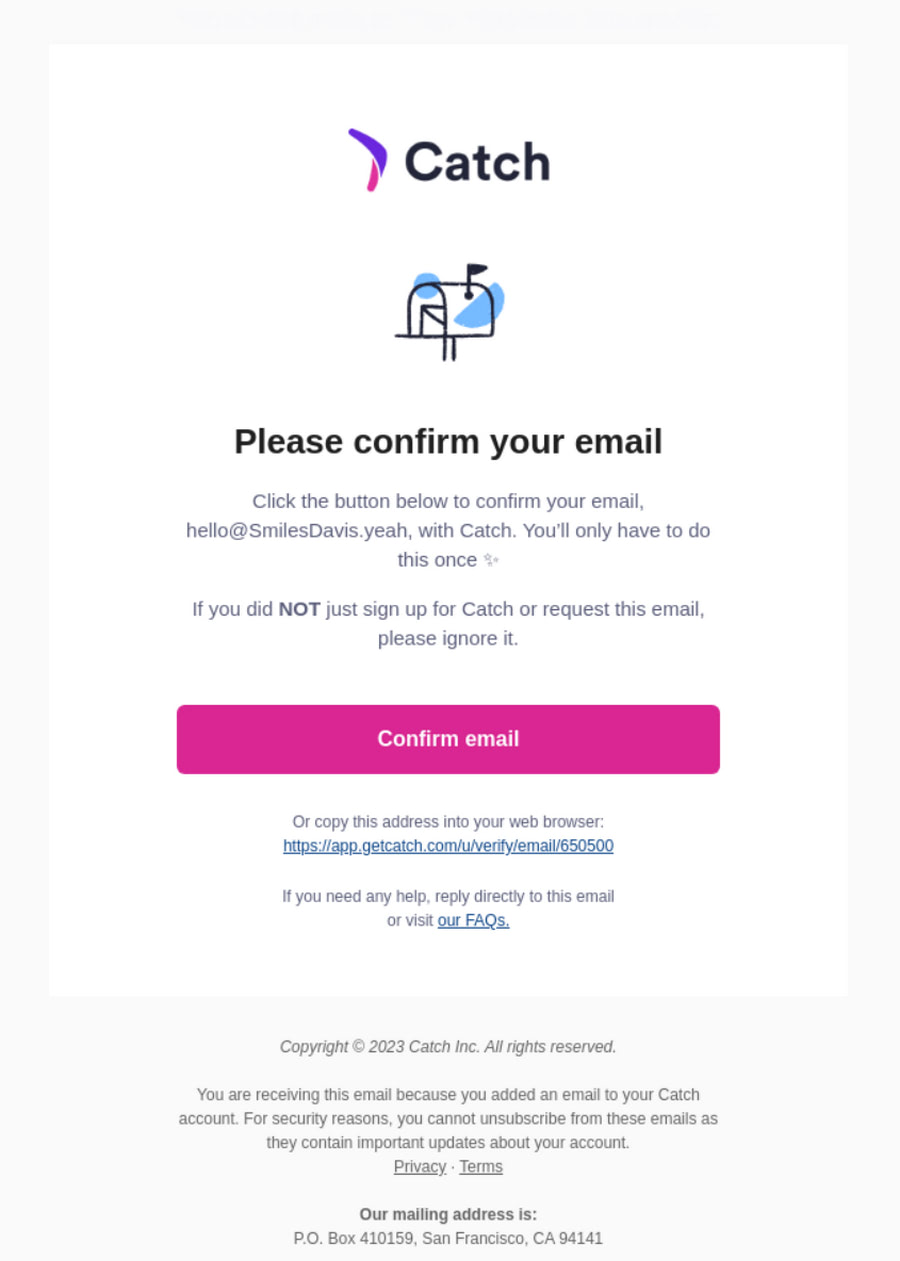
The confirmation email from Catch
Step 3 – Choose a reliable email service provider.
Any respected and well-established EMS does most of the work to help the company comply with the CAN-SPAM and GDPR. Depending on its capacity, it may provide a wealth of features, from collecting proofs of consent to writing your GDPR declaration to adopting the necessary data protection measures in case of a data breach.
The main advantage of using professional email marketing services is that you limit areas and things where you can go wrong. Plus, they keep up with the changes, so you get the solutions that meet the most relevant regulations.
Step 4 – Compose GDPR and CAN-SPAM declarations.
GDRP and CAN-SPAM declarations are privacy notes that inform about your company’s commitment to data protection regulations. As a rule, the company’s official website hosts it. However, your digital newsletter should feature a link to this document if your users have questions.
You may address this step to EMS, which provides a template. However, if you operate on your own, ensure you have included this information: types of personal data you collected, methods of processing this data, situations when you might share personal data with third parties, security measures, and data subject rights.
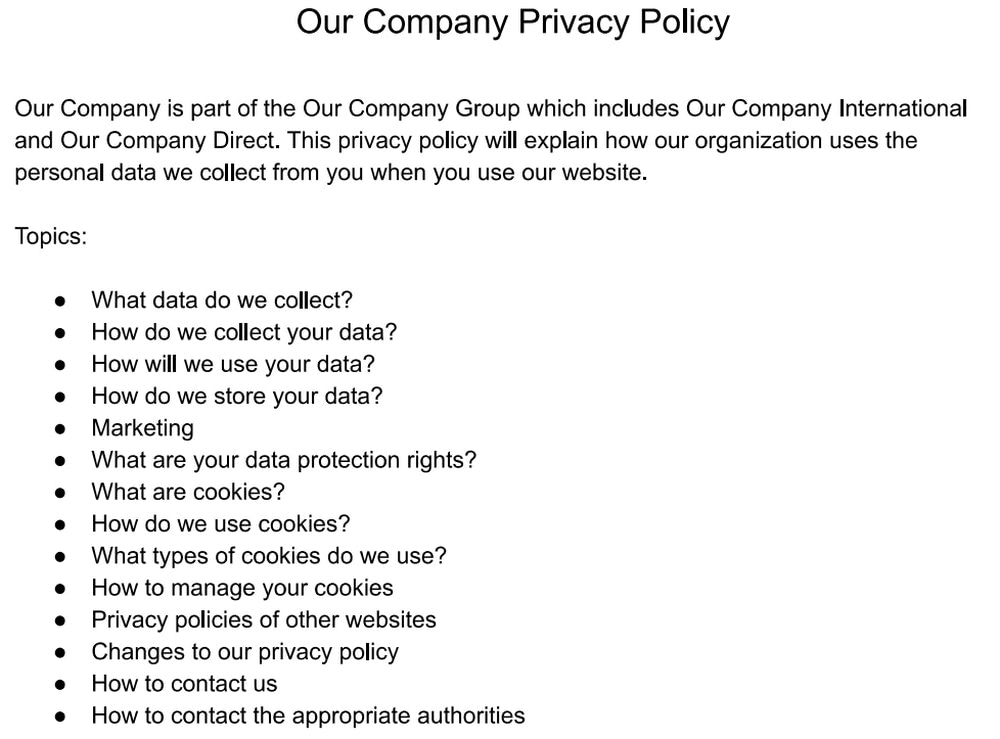
A GDPR-compliant privacy notice (downloadable template)
Every digital newsletter you send subscribers must have certain information to meet CAN-SPAM and GDPR compliances. As practice shows, the best way to show it is in the footer. The reason is simple: it is the first place where users will seek this information because they got used to doing that on the website.
So, what to include?
First and foremost, add a physical address with a valid physical postal index. It is also highly recommended that you specify your telephone and email address.
Second, add a link to the unsubscribe page. Both laws state that the opt-out mechanism must be easily accessible for users. Therefore, add a link or a button to lead your subscribers to the page where they can quickly, easily, and freely get out of your mailing list. Make sure the link is self-explanatory and stands out in the text. As for unsubscribing routine, it should have no more than two steps.
Third, give the links to relevant policies. You may also provide links to related customer support articles and active chat with the support team.
Fourth, add a button to manage preferences. Invite users to control the emails they want to receive from your brand.
Fifth, consider adding links to active social media accounts. Provide your subscribers with all possible ways to contact you.
Finally, provide all necessary descriptions to instruct individuals about each link you have. Make sure they know what to click to address their issue. Clarity should be in every detail and step.
It sounds like a lot of work to do. However, it is crucial to operate legally in the email channel. If you want to do this quickly and efficiently, use Postcards email builder. It has several predefined footer blocks, modules, and styles. You might compose this section within minutes.
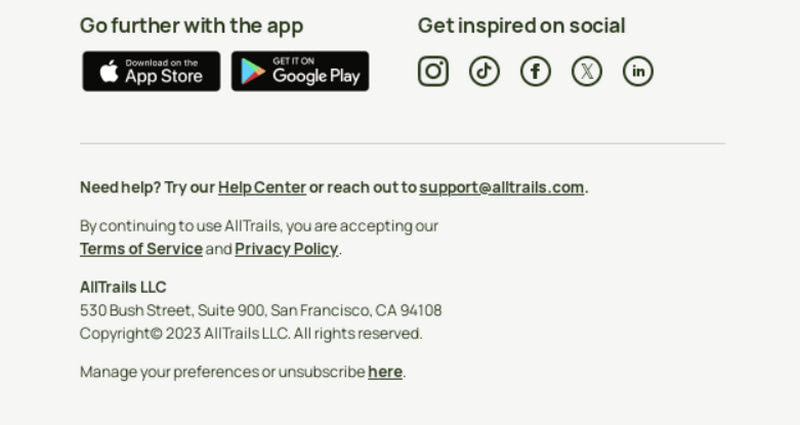
Step 6 – Think through the content and subject line.
Subject lines and content are the driving force of conversions. They persuade customers and lead them to the sales funnel. Therefore, both laws state that they must not be misleading and deceiving.
Start with creating a clean, non-pushy subject line. Ensure it properly explains the purpose and the key message of the email body copy. Do not use capitalization or exclamation marks. Play the FOMO and scarcity cards carefully.
Then, move to the content. Make sure it is not pushy, deceiving, or abusive. Avoid spammy words and grammatical mistakes. Add only appropriate visual material. If you send an advertisement, disclose this fact clearly and conspicuously.
Afterward, consider accessibility. Not only should opt-in and opt-out processes be simple and easily accessible, but so should email content. The unsubscribe button, physical address, contact information, and all critical details that meet CAN-SPAM and GDPR compliances must be well-highlighted and available for screen readers or voice-activated tech.
Finally, make sure your “To,” “From,” “Reply-To,” and routing information is valid. Use only the originating domain name and email address.
Step 7 – Audit your email with Unspam.
Whatever great subject line or informative footer you have composed, it is crucial to audit your email to master CAN-SPAM and GDPR compliance. Running your email through a deliverability test determines weak spots and inconsistencies that may generate spam reports and cause fines for law violations.
There is no other way to do this efficiently than to use Unspam, a professional email spam checker and deliverability test. Add your email newsletter design and run it through its rigorous test to inspect all critical details, such as content, subject line, and technical settings. The service will highlight all faux-pas you must eliminate to pass spam filters.
On top of that, it will check your SPF, DMARC, and DKIM configurations. They are crucial to ensure secure email connection with the subscribers and ipso facto meet CAN-SPAM and GDPR rudimentary laws.
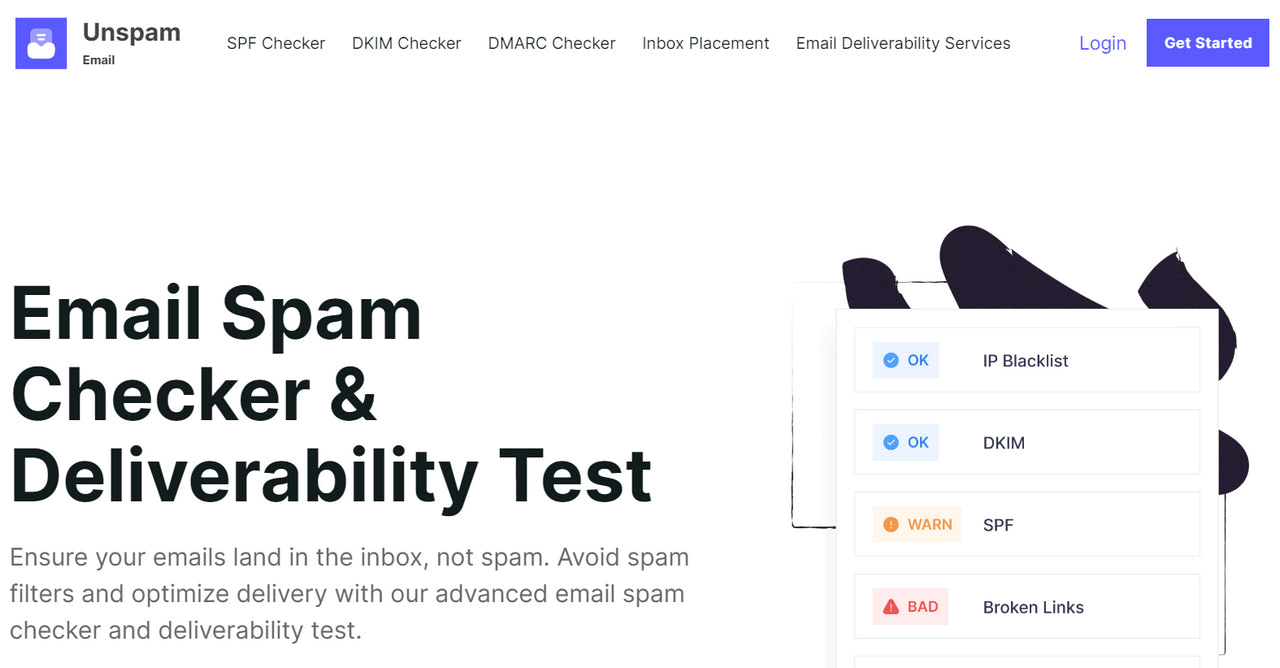
Unspam – a professional email spam checker and deliverability test
Step 8 – Keep your promise.
The last step is to keep your promise and follow CAN-SPAM and GDPR no matter what. Start honoring your user’s request to opt out of your mailing list quickly. GDPR gives you 72 hours, whereas CAN-SPAM gives you ten business days. Make the unsubscribe process simple, quick, and free. Update user’s preferences at their request right away. If people do not consent to marketing emails, never send them to them.
Among other acts to follow and fulfill are:
- Notify users about data breaches within several days and take every possible measure to minimize the impact of the aftermath.
- Monitor your partners. Even if you use EMS, you cannot avoid your legal responsibility to comply with the law. Therefore, make sure they play fair as well.
- Announce any relevant updates to privacy policies.
Finally, adopt the best practices for email marketing: clean the subscription list regularly, never buy contacts, maintain a high sender’s reputation, determine the best email cadence, work with disengaged subscribers, and align your email and unsubscribe page to the latest regulations.
Last but not least
CAN-SPAM and GDPR are not the only regulations that operate in email marketing. If you want to use the channel legally, get acquainted with CASL (Canadian Anti-Spam Law) and CCPA (California Consumer Privacy Act). They are crucial for companies that look to expand their business beyond their borders (state or country).
This may require brands to take extra measures because aligning your internal marketing processes to adhere to multiple laws can be tricky. But at the end of the day, it is worth it. Not only will you save your company from fines, penalties, and tarnished sender reputation, but most importantly, you will become a valid player in the arena that is a socially responsible partner with a deep respect for customer’s rights.
To get answers to all your burning questions, please visit the official portals:
Federal Trade Commission’s website is a great place to look further into CAN-SPAM. It offers a knowledge base and FAQs.
The European Commission is the first place to visit to get a complete review of GDPR. You may find here the history, timeline for enforcement, fundamental rights, and key changes to previous laws. It also includes an FAQ section so you may get answers to the most popular questions quickly.
The official website of the State of California Department of Justice comprises everything you might need to familiarize yourself closely with CCPA. It has general information, a FAQ block, and links to related topics.
The Government of Canada portal includes a wealth of information concerning CASL. It offers help in this matter to the full extent.
There are plenty more resources available online that may help you to ensure you are complying with all communications laws. For instance, you may visit the IAPP or Association of National Advertisers for more educational resources, training, and publications.
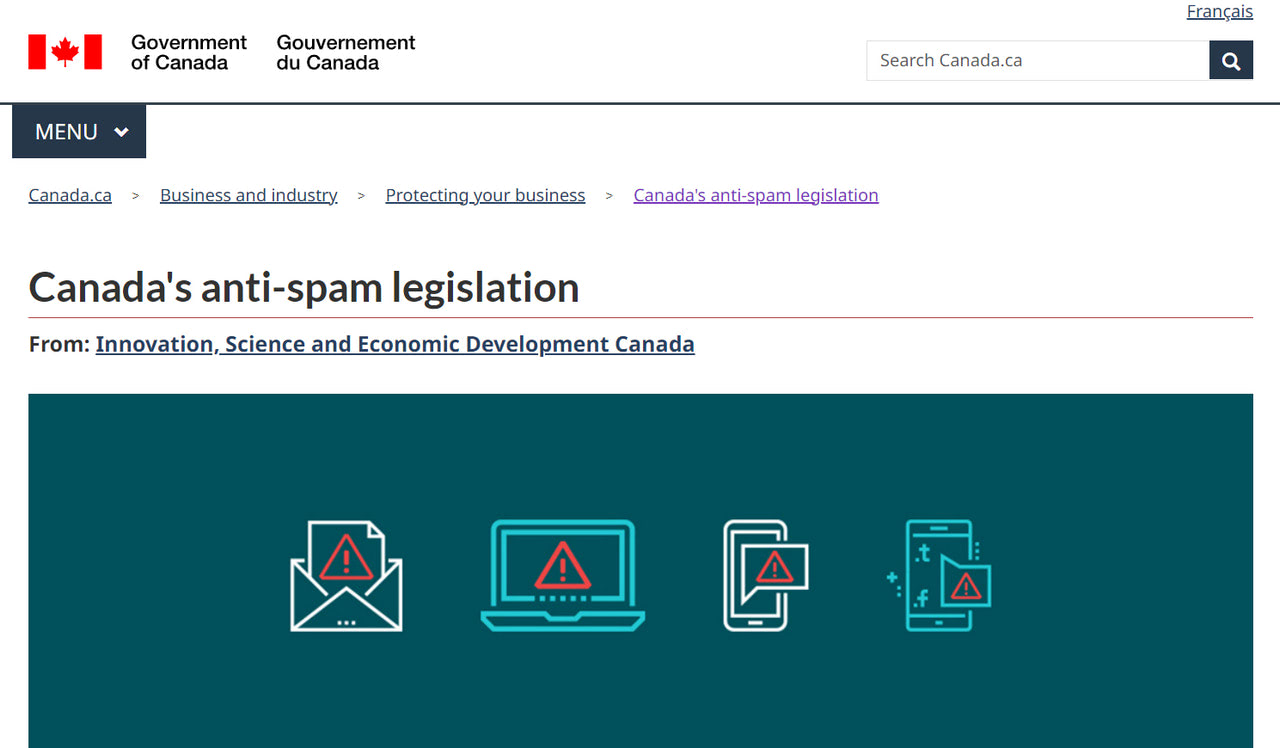
Conclusion
The CAN-SPAM and GDPR are still in its early phase. As short as five years are in regulatory terms, they have achieved significant results. According to recent studies, over 80% of respondents trust companies that follow CAN-SPAM and GDPR because of strong data security control. As for global influence, only 15% of countries ignore the importance of implementing data privacy protection measures.
Data protection and regulation laws have improved email marketing governance, monitoring, awareness, and strategic decision-making. They helped companies to find a way to build trust with customers and legally operate within certain regions.
Although compliance with these regulations is an ongoing process that requires thousands and even millions of investments from some companies, it is worth it. They bring numerous benefits for both parties and create a safe and positive digital environment.



